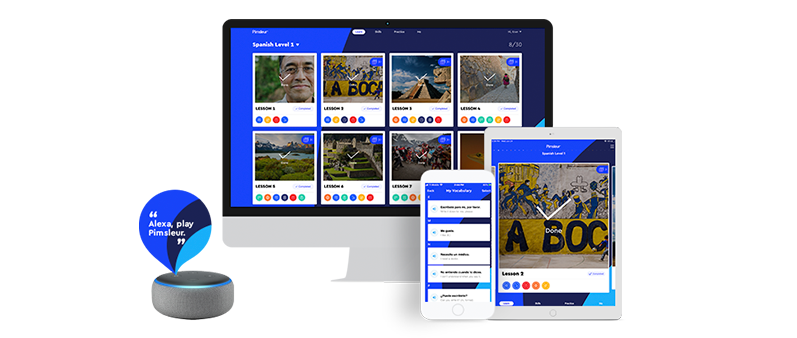
Spanish Greetings and Grammar Tips
Did you know that Spanish has 661 million speakers around the globe? This makes Spanish the third most spoken language in the world. ¡Eso es un montón! (That is a lot!)
Today, we are going to dive into the basics and explore the most common Spanish greetings and responses.
Our guide will cover the most important skill in any language: introductions. We’ll explore 3 easy ways to introduce yourself in Spanish, including in formal, informal, and even nonverbal settings. By the end of this, you will have the skills to greet like a local.
So let’s get started on how to introduce yourself in Spanish. First off, let’s go over some basics.
Grammar 101: How to Introduce Yourself in Spanish

You might be thinking, “let’s just dive right in and learn how to greet people in Spanish! That way I can meet Maluma and tell him how big of a crush I have on him.” But before we can begin to make introductions or date famous Spanish singers, we need to learn some simple grammar first.
We’ve created a set of easy-to-learn tricks for oral and written Spanish introductions. With these grammar tips, it will be so much easier to learn common Spanish greetings and responses!
Important Spanish Pronouns
First, let’s talk about some pronouns. We will begin with the pronoun “usted.” Usted is the Spanish word for you and is typically used in formal situations. For instance, you would use usted when speaking to a boss, teacher, customer, or older individual. Usted is more commonly used in Latin America than in Spain.
Here is an example: Let’s pretend that you are a secretary and a client just called to check on the time of their appointment that day. You may say, “Usted tiene una cita a las 2 de la tarde.” This means, “You (formal) have an appointment at 2 in the afternoon.”
Next, tú also means you but is used for informal situations like conversations with friends and family.
For example, think of the famous lyrics of “El Perdón” by Enrique Iglesias and Nicky Jam. “ Y tú sin mi, dime quién puede ser feliz…” This means “And you (informal) without me, tell me who can be happy…”
What’s Up with the Upside-Down Question Marks in Spanish
In written Spanish, an inverted, or upside-down question mark (¿) is placed at the beginning of any question and a standard question mark is placed at the end. This rule also applies to exclamation points.
Take this example: You are introducing yourself and state your name with a follow-up question. You may say “Yo me llamo Hannah, ¿y tú?” This means “My name is Hannah, and yours?” Note the placement of the question marks and the use of the upside-down question mark.
We’ve covered the basics, so let’s get started!
3 Easy Ways to Introduce Yourself in Spanish

1. Formal Greeting
As mentioned above, if you’re talking to someone of authority like a professor or boss, you’ll want to use a formal greeting to introduce yourself. Remember, we want to use “usted” as the formal version of “you.” Here are some examples to get you started.
Hola, ¿Cómo está usted? – Hello, how are you?
This is a formal way to ask how someone is feeling. While conducting business, this is an important question to ask because it shows that you care about the well-being of your colleagues.
So, what happens if someone asks you this question? How should you respond? No worries, we have the perfect set of answers for you. If you are wondering how to respond to this greeting, you can say:
- Muy bien, ¿y usted? Very good, and you?
- Estoy bien, gracias. I am well, thank you.
- Estoy mal/no estoy bien. I am bad/I am not well.
It’s as easy as that!
¿Cómo va su día?- How is your day going?
This expression shows genuine interest in other’s lives and creates a personal connection with them. Although not as common as ¿Cómo está usted?, it is still a popular expression in the Spanish-speaking world and can be considered to be more personal.
Also, take note that the use of “su” instead of “tu.” Su (your, formal) is the formal version of tu (your, informal) and makes the greeting more proper.
¿Cómo le va?– How is it going?
Now, consider this: phrases like the one above still use the third personal pronoun of usted, even though the word is not present in the sentence. The word “le” replaces usted and means “it.” You can also tell that the phrase is formal because of the conjugation of the verb “ir” (to go). For instance, if the sentence was informal, the conjugation would be “vas” (you go, informal). However, since usted is the pronoun, the conjugation is “va” (you go, formal).
Pro-tip: Want to learn more formal expressions? Youtube can be a great resource for extra practice! Check out these top YouTube channels to practice Spanish.
2. Informal Greeting
An informal greeting is most commonly used when saying hello to people you are comfortable with and already know, like friends and family. Keep reading and become a master at informal greetings.
Ey, Oye, Buenas– Hi
These are the Spanish equivalents of “hi” in English. They are a refreshing and more local way of saying hola. You can use ey, oye, or buenas to create a casual tone when talking to friends. However, never use these expressions in more formal settings, they will not be appropriate.
¿Cómo estás?– How are you?
You must be thinking, “ Isn’t this the same example as the one for formal greetings?” Technically, yes it is – except for one small detail.
Notice that this example has an s at the end of the word está while the previous example did not. This makes all the difference! Based on the verb form, we know it uses the second personal pronoun, tú, which makes the sentence informal.
You can respond to this question with the following:
- Muy bien, ¿y tú? Very good, and you?
- Estoy mal/no estoy bien. I am bad/I am not well.
Now that you know how to respond to this common Spanish greeting, let’s move on to the next one.
¿Que tal?– What’s up? How are you doing?
This expression also means “How are you doing,” but it is way less formal. You can use this colloquial phrase in virtually any casual setting.
Now that you know the basic Spanish greetings and responses, let’s talk about non-verbal ways to introduce yourself in Spanish culture.
3. Non-Verbal Introductions
Another widely used greeting in Hispanic culture is kissing on the cheeks. It’s as popular as a handshake for English-speakers and is used to say hello and goodbye. This greeting should be used in informal settings with friends and family. In a formal setting, you should stick with a handshake.
So, how do you master cheek kissing etiquette? Realistically, your lips don’t have to touch the other person’s cheek. You simply place your cheeks together and make the sound of a kiss.
But wait, there’s more!
In Spain, people tend to kiss twice – one for each cheek. However, in many Latin American countries, people may only kiss once.
Caveat! These are not normal times and so traditions around the world are currently on pause. During the pandemic, you should probably stick with an enthusiastic wave from a safe distance.
¡Oye! ¿Estás listo para aprender más? (Hi! Are you ready to learn more?)
Now that you know how to introduce yourself in Spanish, you’ve taken the first step in discovering more about Hispanic culture and language.
Want to go even further? Master Spanish language skills and core vocabulary with our proven Pimsleur language method.
Want to get a feel for the program? Jump into a Free Lesson right now!

2 Comments for "How to Introduce Yourself in Spanish"
Thanks for the article! I especially liked the non-verbal introductions part. I have not seen other writers include that and I know for a fact those non-verbal introductions are huge in Spanish-speaking countries!
Here’s my take on how to greet others and say goodbye in Spanish (I made audios too!). It would be an honor if my resource helps others in their journey.
https://spanishtutoring.com/spanish-greetings/
– Emilio, contributor at SpanishTutoring.com
Interesting